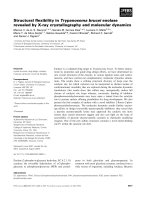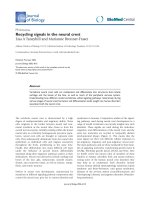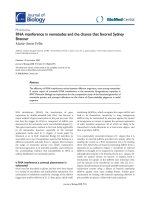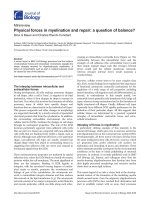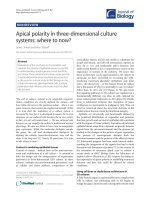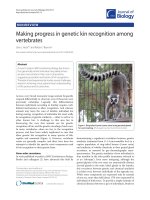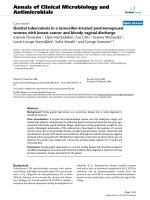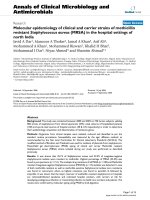Báo cáo sinh học: "Chromosomal rearrangements in cattle and pigs revealed by chromosome microdissection and chromosome painting" pptx
Bạn đang xem bản rút gọn của tài liệu. Xem và tải ngay bản đầy đủ của tài liệu tại đây (1.12 MB, 12 trang )
Genet. Sel. Evol. 35 (2003) 685–696 685
© INRA, EDP Sciences, 2003
DOI: 10.1051/gse:2003047
Original article
Chromosomal rearrangements
in cattle and pigs revealed
by chromosome microdissection
and chromosome painting
Alain P
INTON
a
, Alain D
UCOS
a∗
, Martine Y
ERLE
b
a
UMR INRA-ENVT cytogénétique des populations animales,
École nationale vétérinaire de Toulouse,
23, chemin des Capelles, 31076 Toulouse Cedex 3, France
b
Laboratoire de génétique cellulaire,
Institut national de la recherche agronomique,
Auzeville BP 27, 31326 Castanet-Tolosan Cedex, France
(Received 12 December 2002; accepted 7 May 2003)
Abstract – A pericentric inversion of chromosome 4 in a boar, as well as a case of (2q−;5p+)
translocation mosaicism in a bull were analysed by chromosome painting using probes generated
by conventional microdissection. For the porcine inversion, probes specific for p arms and q
arms were produced and hybridised simultaneously on metaphases of a heterozygote carrier. In
the case of the bovine translocation, two whole chromosome probes (chromosome 5, and derived
chromosome 5) were elaborated and hybridised independently on chromosomal preparations of
the bull who was a carrier of the mosaic translocation. The impossibility of differentiating chro-
mosomes 2 and der(2) from other chromosomes of the metaphases did not allow the production
of painting probes for these chromosomes. For all experiments, the quality of painting was
comparable to that usually observed with probes obtained from flow-sorted chromosomes. The
results obtained allowed confirmation of the interpretations proposed with G-banding karyotype
analyses. In the bovine case, however, the reciprocity of the translocation could not be proven.
The results presented in this paper show the usefulness of the microdissection technique for
characterising chromosomal rearrangements in species for which commercial probes are not
available. They also confirmed that the main limiting factor of the technique is the quality of
the chromosomal preparations, which does not allow the identification of target chromosomes
or chromosome fragments in all cases.
chromosome / rearrangement / microdissection / cattle / pig / chromosome painting
∗
Corresponding author:
686 A. Pinton et al.
1. INTRODUCTION
The chromosomal control programmes carried out in livestock populations,
especially in France [7], allow the detection of numerous chromosomal abnor-
malities [6,8–10,31]. All chromosomal abnormalities have been primar-
ily identified using classical chromosome staining techniques (G-, and/or
R-banding). On several occasions, the use of complementary molecular
cytogenetic techniques has allowed the improvement of the characterisation
of the rearrangements by defining the accurate localisation of the breakpoints,
and by demonstrating the reciprocity of some translocations [30,31]. This
approach, very classic in humans, is still little used in animal cytogenetics. To
our knowledge, only 17 papers have been published so far for farm species:
five in the pig [10,23,28,30,31], eight in cattle [12,17–22,29], three in the
horse [1, 26,44], and one in poultry [32]. One of the reasons is, up to a
recent period, the limited availability of probes. Indeed, on the contrary to
the human situation, no commercial molecular probe has been developed for
livestock species, even for the most important ones (in several studies cited
above, e.g. [18,26,28], the fluorescent in situ hybridisation (FISH) experiments
were carried out using heterologous human painting probes). Complete or
partial collections of chromosome-specific probes have been generated by flow
sorting for numerous species including the pig [25,45], cow [35], sheep [2] and
chicken [14]. Nevertheless, the complexity of the karyotypes does not always
allow the separation of all chromosomes. For instance, no more than twenty-
two among thirty chromosome types have been separated as pure fractions
for the cow, and for the swine, chromosomes 9 and X remain unresolved
by flow cytometry. Unlike flow-sorting techniques which are limited to the
chromosomes that can be isolated as peaks on bivariate sorting profiles, the
microdissection strategy can be applied to any chromosome of any species
with cytogenetically identifiable chromosomes [15]. In addition, it also allows
the production of chromosome-arm or chromosome-band probes. The use
of this technique for the characterisation of chromosomal rearrangements has
been frequently reported in man (e.g. [42,43]), but rarely in animals [24,34].
Indeed, the few applications in livestock species have been mainly aimed at
developing genomic libraries for specific regions of interest (e.g. [33, 41]).
Painting probes have been produced by microdissection, for instance in cattle,
pigs and horses [3,13,24], as well as chickens [14,16,46], but mainly for com-
parative Zoo-FISH purposes. In this paper, we report the use of conventional
microdissection for the production of whole chromosome and chromosome
arm painting probes, and their use for the subsequent accurate characterisation
of two distinct chromosomal rearrangements: (1) a pericentric inversion of
chromosome 4 in a boar, and (2) a mosaic with 15% of the cells bearing a 2/5
translocation in a bull.
Chromosome microdissection in cattle and pigs 687
2. MATERIALS AND METHODS
2.1. Animals – Previous identification of the chromosomal
rearrangements
2.1.1. Porcine case
The first abnormality (pericentric inversion of one chromosome 4) was
initially identified using GTG-banding in four young Large White boars
used in artificial insemination centres. The chromosomal rearrangement has
been described, according to the standard nomenclature, as 38, XY, inv(4)
(p14;q23) [5]. No phenotypic effect was associated to this particular balanced
rearrangement. The fertility of the heterozygous boars (average prolificacy of
their mates) was unaltered.
2.1.2. Bovine case
The second rearrangement was identified in a young bull of the Blonde
d’Aquitaine breed. Two kinds of cells were found in the lymphocyte culture:
normal ones (60, XY), and cells carrying a translocation. The chromosomes
involved in the rearrangement (BTA2 and BTA5) were identified on GTG-
banding preparations. The presence of translocated cells in other tissues (skin
fibroblast) allowed us to demonstrate the mosaic nature of the rearrangement.
The overall rate of translocated cells was 15%. This chromosomal abnorma-
lilty appeared de novo (the parents had normal karyotypes). No phenotypic
abnormality was observed on the carrier. Its fertility could not be estimated
since the owner culled it before reproduction.
2.2. Chromosomal preparations
The mitotic chromosomes used for microdissection and chromosome paint-
ing were obtained from classical Pokeweed stimulated lymphocyte cultures
(see [6] for details). Hypotonic treatment (1/6 calf serum) was followed by
a soft fixation in methanol:acetic acid 3:1 (3 series of 2 min). Chromosome
preparations were spread onto grease-free cover slips, treated with 0.1% Trypsin
(Difco, Becton Dickinson, Sparks, USA) and stained with 3% Giemsa solution
to generate GTG banding.
2.3. Microdissection
Conventional microdissection was first used to generate SSC4p arm and
SSC4q arm probes (characterisation of the porcine pericentric inversion). For
the analysis of the bovine translocation, normal chromosomes 5 and chromo-
some 5 derivatives were scraped to generate two distinct whole chromosome
probes. Microdissection was performed using glass microneedles made using a
688 A. Pinton et al.
Narishige vertical pipette puller. Chromosome scraping was carried out under
an inverted Zeiss microscope using a Narishige micromanipulator, according
to the Engelen protocol [11] with slight modifications. Briefly, the porcine
chromosome 4p arms were first dissected on dry slides. The metaphase of
interest was then covered with 2 µL of sterile distilled water. The 4 to 5
fragments generated stuck instantly to the needle tip and were collected. The
remaining 4q arm fragments became sticky and could then be collected as a
whole with a new microneedle. The normal and der(5) bovine chromosomes
were microdissected as explained above for the chromosome 4q arms. Twenty
copies of each arm or chromosome were collected and transferred to a 5 µL
collection drop containing 40 mmol · L
−1
Tris-HCl, pH 7.5, 20 mmol · L
−1
MgCl
2
, 50 mmol · L
−1
NaCl, 200 µmol · L
−1
of each dNTP, 1 unit of Topoi-
somerase (Promega, Madison, USA) and 5 pmol of universal DOP-PCR primer
5
-CCGACTCGAGNNNNNNTGTGG-3
[40].
2.4. Elaboration of the painting probes, hybridisation and image
analysis
Amplification of microdissected DNA was performed according to [13],
i.e. 8 initial cycles at a low annealing temperature (94, 30, and 72
◦
C) using
a sequenase version 2.0 DNA polymerase (Usb, Amersham, Orsay, France),
followed by 40 cycles at a higher temperature (94, 56, and 72
◦
C) using an
AmpliTaq DNA polymerase (Applied Biosystems, Foster City, USA). Ampli-
fied microdissected products were subsequently labelled with 100 µmol · L
−1
biotin-16-dUTP or digoxygenin-11-dUTP (Boeringher, Mannheim, Germany)
in a 20 cycle PCR identical to that cited above. The PCR products were then
purified through G50 chromatography columns and precipitated with 15 µg
of competitor DNA at −20
◦
C overnight. The pellet was suspended in 10 µL
of classical hybridisation mixture. Hybridisation, signal detection and image
treatment were performed as described in [30].
3. RESULTS
The initial DOP-PCR products were first analysed by electrophoresis in
a 0.8% agarose gel (generation of 200 to 800 bp DNA fragments for all
microdissected chromosomes or chromosome arms).
3.1. Porcine case: inv(4) (p14;q23)
The specificity of the 4p and 4q arm probes was first tested using single colour
FISH on metaphases of a normal pig. Clear and strong specific signals could
be observed. These two probes were then labelled differently and hybridised
Chromosome microdissection in cattle and pigs 689
simultaneously on metaphases of an animal heterozygous for the pericentric
inversion (p arm probe revealed with Texas-Red, q arm probe revealed with
FITC). The normal (1 arm = 1 colour) and inverted (1 arm = 2 colours)
chromosomes could be clearly distinguished (Fig. 1). This experiment allowed
us to demonstrate without ambiguity the nature of the rearrangement and to
determine precisely the size of the chromosome fragments involved.
3.2. Bovine case: 2q−/5p+ translocation
The chromosome 5 probe generated by microdissection (biotin-labelled and
revealed by FITC) was first hybridised on metaphases of the bull who was a
carrier of the mosaic translocation. The analysis of normal cells allowed us
to confirm the probe specificity (Fig. 2a). The analysis of cells carrying the
translocation revealed two signals (Fig. 2b). One corresponded to the normal
BTA5 chromosome (chromosome entirely stained), and the other one to the
der(5) chromosome, exhibiting an unstained fragment corresponding to the
chromosomal material translocated from one chromosome 2.
The der(5) chromosome probe produced was then hybridised on similar
chromosome preparations. Four clear signals could be distinguished on normal
cells (Fig. 3a). The two entirely stained chromosomes corresponded to the
normal BTA5 chromosomes. The remaining two corresponded to the normal
partially labelled BTA2 chromosomes. The determination of the size of the
stained segments on these chromosomes allowed us to confirm the location of
the breakpoint on chromosome 2q33. The analysis of the cells carrying the
translocation revealed three painted chromosomes (Fig. 3b): as expected, one
normal chromosome 5 and the der(5) chromosome appeared entirely stained,
whereas only the 2q33 → 2qter segment of the normal chromosome 2 was
painted. These experiments allowed us to clearly demonstrate the transloca-
tion of one 2q33 → 2qter segment to one chromosome 5. On the contrary,
the reciprocal translocation of a centromeric (very short) fragment of one
chromosome 5 to the der(2) chromosome could not be proven.
4. DISCUSSION
The first application of chromosome microdissection in animal genetics
(livestock species) dates back to 1994 [36]. The aim was then to develop a
bovine genomic library from scraped Robertsonian 1/29 translocated chromo-
somes. The majority of the applications that followed had the same mapping
purposes. On the contrary, the microdissection-based characterisation of
chromosomal rearrangements in farm species has been reported only once
before [26]. The results shown in the current paper illustrate the validity
of this strategy. In both cases, the probes obtained produced specific and
bright paints, comparable to those obtained using homologous probes from
690 A. Pinton et al.
Figure 1.
Figure 2.
Chromosome microdissection in cattle and pigs 691
←
Figure 1. Hybridisation of SSC4p (in red) and SSC4q arm (in green) probes on meta-
phases of a boar heterozygous for the inv(4)(p14;q23) pericentric inversion; (a) normal
chromosomes, and (b) inverted chromosomes. On the left: FISH signals observed on
complete metaphases. On the right: details (GTG-banding chromosomes, ideograms,
and FISH signals). The arrows indicate the putative breakpoints on chromosome 4.
←
Figure 2. Hybridisation of the BTA5 painting probe on normal (a) and translocated
(b) metaphases. On the left: FISH signals observed on complete metaphases. On the
right: details (GTG-banding chromosomes, ideograms, and FISH signals). The arrow
indicates the putative breakpoint on chromosome 5.
Figure 3. Hybridisation of the der(5) painting probe on normal (a) and translocated
(b) metaphases. On the left: FISH signals observed on complete metaphases. On
the right: details (GTG-banding chromosomes, ideograms, and FISH signals). The
arrows indicate the putative breakpoints on chromosomes 5 and 2.
flow-sorted chromosomes. Therefore, for species presenting complex karyo-
types, microdissection can allow the production of painting probes specific for
each chromosome while this is not possible by fow cytometry (for instance,
specific and separate SSC9 and SSCX probes have been produced in our
laboratory using this technique). In addition, it is the only way to produce
painting probes specific of a chromosomal arm or of a smaller chromosomal
region. The potential applications of such paint probes are numerous (accu-
rate characterisation of chromosomal rearrangements, between species chro-
mosome comparisons, phylogeny, i.e. analysis of karyotype evolution etc.).
692 A. Pinton et al.
For instance, microdissection could be used to produce the probes that are
necessary to develop the pig 20 colour karyotype, as well as multicolour
banding probes for particular chromosomes or chromosome sets [27]. This
kind of approach (SKY-FISH [37], M-FISH [39]) could allow, as in man, the
identification of chromosomal rearrangements that would have escaped detec-
tion using standard chromosome banding techniques [38]. Some explanations
could be brought forward in cases of severe hypoprolific boars for which no
chromosomal rearrangements were detected on GTG-banded karyotypes [9].
The most satisfying results presented in this paper concerned the porcine
pericentric inversion. They allowed the validation of the hypothesis put forward
after the preliminary analyses [5] (Fig. 1), and helped to accurately locate the
breakpoints.
The results obtained for the bovine translocation were also interesting since
they confirmed the nature of the chromosomes involved in the rearrangement,
and also improved the localisation of the breakpoint on the BTA2 chromosome.
A complete analysis however, would have required the hybridisation of the com-
plementary painting probe for chromosome 2 and/or derivative chromosome 2.
Unfortunately, it is very difficult to identify these chromosomes without ambi-
guity on the metaphases. For instance, BTA2 appeared to be very similar to
BTA1 on medium quality preparations, and the derivative chromosome 2 was
a small chromosome very similar to BTA12 or BTA15. The quality of our
preparations was clearly insufficient to face the isolation of 20 copies of each
of these chromosomes. The quality of the spreading was especially poor, due
to the particular fixation procedure carried out, which is necessary in order
not to compromise the amplification of the microdissected material. A new
strategy has been recently proposed [4] that allows the production of efficient
paint probes from only one copy of microdissected material, using in situ DOP-
PCR. This approach could be of help to overcome the problems discussed above,
mainly due to the difficult detection of the target chromosomes on poor quality
preparations. The simultaneous dual-colour hybridisation, on translocated
chromosomes, of a BTA5 painting probe and of two BAC (or cosmid) probes
located at the extremities of the fragment translocated from BTA2 could also
have definitively proven the origin of the non-stained chromosome fragment
on the der(5) chromosome (Fig. 2b). In addition, the breakpoint on BTA5
being located in the centromeric region, another strategy, using for instance
a centromeric probe specific for this chromosome (FISH or primed in situ
DNA labelling – PRINS), could have been interesting. Unfortunately, such a
probe is not yet available in cattle. Nevertheless, the analysis of the banding
karyotypes as well as the painting results obtained here allowed a rather clear
determination of the chromosomes involved in the rearrangement. This level of
analysis is quite sufficient in this particular case since only one animal bearing
this abnormality has been detected up to now.
Chromosome microdissection in cattle and pigs 693
REFERENCES
[1] Breen M., Langford C.F., Carter N.P., Fischer P.E., Marti E., Gerstenberg C.,
Allen W.R., Lear T.L., Binns M.M., Detection of equine X chromosome abnor-
malities in equids using a horse X whole chromosome paint probe (WCPP), Vet.
J. 153 (1997) 235–238.
[2] Burkin D.J., O’Brien P.C., Broad T.E., Hill D.F., Jones C.A., Wienberg J.,
Ferguson Smith M.A., Isolation of chromosome specific paints from high res-
olution flow karyotypes of the sheep (Ovis aries), Chromosome Res. 5 (1997)
102–108.
[3] Chaudhary R., Kijas J., Raudsepp T., Guan X.Y., Zhang H., Chowdhary B.P.,
Microdissection of pig chromosomes: dissection of whole chromosomes, arms
and bands for construction of paints and libraries, Hereditas 128 (1998) 265–271.
[4] Christian A.T., Garcia H.E., Tucker J.D., PCRin situ followed by microdissection
allowswholechromosome painting probes to be made from singlemicrodissected
chromosomes, Mamm. Genome 10 (1999) 628–631.
[5] Ducos A., Pinton A., Seguela A., Berland H.M., Blanc M.F., Sans P., Darré A.,
Pinton P., Yerle M., Darré R., Pericentric inversion of the chromosome No. 4 in
pig, Genet. Sel. Evol. 29 (1997) 383–394.
[6] Ducos A., Berland H.M., Pinton A., Guillemot E., Seguela A., Darre A., Darre
R., Nine new cases of reciprocal translocation in the domestic pig, J. Hered. 89
(1998) 136–142.
[7] Ducos A., Berland H.M., Pinton A., Séguéla A., Brun-Baronnat C., Darré A.,
Darré R., Contrôle chromosomique des populations animales d’élevage, INRA
Prod. Anim. 13 (2000) 25–35.
[8] Ducos A., Dumont P., Séguéla A., Pinton A., Berland H.M., Brun-Baronnat C.,
Darré A., Marquant-Le Guienne B., Humblot P., Boichard D., Darré R., A new
reciprocal translocation in a subfertile bull, Genet. Sel. Evol. 32 (2000) 589–598.
[9] Ducos A., Pinton A., Séguéla A., Berland H.M., Brun-Baronnat C., Bonnet N.,
Darré R., Contrôle chromosomique des populations porcines en France : bilan
de 5 années d’activité, Journ. Rech. Porcine 34 (2002) 269–275.
[10] Ducos A., Pinton A., Yerle M., Séguéla A., Berland H.M., Brun-Baronnat
C., Darré R., Cytogenetic and molecular characterization of 8 new reciprocal
translocations in the pig species. Estimation of their incidence in the French
populations, Genet. Sel. Evol. 34 (2002) 389–406.
[11] Engelen J.J., Albrechts J.C., Hamers G.J., Geraedts J.P., A simple and efficient
method for microdissection and microFISH, J. Med. Genet. 35 (1998) 265–268.
[12] Gallagher D.S., Lewis B.C., De Donato M., Davis S.K., Taylor J.F., Edwards J.F.,
Autosomal trisomy 20 (61,XX,+20) in a malformed bovine fetus, Vet. Pathol.
36 (1999) 448–451.
[13] Goldammer T., Weikard R., Brunner R.M., Schwerin M., Generation of chro-
mosome fragment specific bovine DNA sequences by microdissection and DOP-
PCR, Mamm. Genome 7 (1996) 291–296.
[14] Griffin D.K., Haberman F., Masabanda J., O Brien P., Bagga M., Sazanov A.,
Smith J., Burt D.W., Ferguson Smith M., Wienberg J., Micro- and machrochro-
mosome paints generated by flow cytometry and microdissection: tools for
mapping the chicken genome, Cytogenet. Cell Genet. 87 (1999) 278–281.
694 A. Pinton et al.
[15] Guan X.Y., Meltzer P.S., Trent J.M., Rapid generation of whole chromosome
painting probes (WCPs) by chromosome microdissection, Genomics 22 (1994)
101–107.
[16] Guiller-Gencik Z., Bernheim A., Coullin P., Generation of whole chromosome
painting probes specific to each chicken macrochromosome, Cytogenet. Cell
Genet. 87 (1999) 282–285.
[17] Iannuzzi L., Di Meo G.P., Perucatti A., Eggen A., Incarnato D., Sarubbi F., Cribiu
E.P., A pericentric inversion in the cattle Y chromosome, Cytogenet. Cell Genet.
94 (2001) 202–205.
[18] Iannuzzi L., Molteni L., Di Meo G.P., Perucatti A., Lorenzi L., Incarnato D.,
De Giovanni A., Succi G., Gustavsson I., A new balanced autosomal reciprocal
translocation in cattle revealed by banding techniquesandhuman painting probes.
Cytogenet. Cell Genet. 94 (2001) 225–228.
[19] Iannuzzi L., Molteni L., Di Meo G.P., De Giovanni A., Perucatti A., Succi G.,
Incarnato D., Eggen A., Cribiu E.P., A case of azoospermia in a bull carrying a
Y-autosome reciprocal translocation, Cytogenet. Cell Genet. 95 (2001) 225–227.
[20] Iannuzzi L., Di Meo G.P., Leifsson P.S., Eggen A., Christensen K., A case of
trisomy 28 in cattle revealed by both banding and FISH-mapping techniques,
Hereditas 134 (2001) 147–151.
[21] Joerg H., Garner D., Rieder S., Suwattana D., Stranzinger G., Molecular genetic
characterization of Robertsonian translocations in cattle, J. Anim. Breed. Genet.
118 (2001) 371–377.
[22] Kawakura K., Miyake Y., Murakami R.K., Kondoh S., Hirata T.I., Kaneda Y.,
Abnormal structure of the Y chromosome detected in bovine gonadal hypoplasia
(XY female) by FISH, Cytogenet. Cell Genet. 76 (1997) 36–38.
[23] Konfortova G.D., Miller N.G.A., Tucker E.M., A new reciprocal translocation
(7q+;15q−) in the domestic pig, Cytogenet. Cell Genet. 71 (1995) 285–288.
[24] Kubickova S., Cernohorska H., Mulisova P., Rubes J., The use of laser micro-
dissection for the preparation of chromosome-specific painting probes in farm
animals, Chromosome Res. 10 (2002) 571–577.
[25] Langford C.F., Telenius H., Miller N.G., ThomsenP.D., Tucker E.M., Preparation
of chromosome-specific paints and complete assignment of chromosomes in the
pig flow karyotype, Anim. Genet. 24 (1993) 261–267.
[26] Lear T.L., Layton G., Use of Zoo-FISH to characterise a reciprocal translocation
in a thoroughbred mare t(1;16) (q16;q21.3), Equine Vet. J. 34 (2002) 207–209.
[27] Liehr T., Heller A., Starke H., Rubtsov N., Trifonov V., Mrasek K., Weise
A., Kuechler A., Claussen U., Microdissection based high resolution multicolor
banding for all 24 human chromosomes, Int. J. Mol. Med. 9 (2002) 335–339.
[28] Mäkinen A., Andersson M., Nikunen S., Detection of the X chromosomes in
a Klinefelter boar using a whole human X chromosome painting probe, Anim.
Reprod. Sci. 52 (1998) 317–323.
[29] Miyake Y.I., Kawakura K., Murakami R.K., Kaneda Y., Minute fragment
observed in a bovine pedigree with Robertsonian translocation, J. Hered. 85
(1994) 488–490.
[30] Pinton A., Ducos A., Séguéla A., Berland H.M., Darré R., Darré A., Pinton P.,
Schmitz A., Cribiu E.P., Yerle M., Characterization of reciprocal translocations
Chromosome microdissection in cattle and pigs 695
in pigs using dual-colorchromosome painting and PRINS, Chromosome Res. 6
(1998) 361–365.
[31] Pinton A., Ducos A., Berland H.M., Séguéla A., Brun-Baronnat C., Darré A.,
Darré R., Yerle M., Chromosomal abnormalities in hypoprolific boars, Hereditas
132 (2000) 55–62.
[32] Ramos P.S., Bitgood J.J., Ponce De Leon A., Novel chromosomal translocation
in chicken uncovered by double colour FISH, Anim. Biotechnol. 10 (1999)
119–122.
[33] Sarker N., Hawken R.J., Takahashi S., Alexander L.J., Awata T., Schook L.B.,
Vasue H., Directed isolation and mapping of microsatellites from swine Chro-
mosome 1q telomeric region through microdissection and RH mapping, Mamm.
Genome 12 (2001) 524–527.
[34] Schelling C., Pienkowska A., Arnold S., Hauser B., Switonski M., A male to
female sex-reversed dog with a reciprocal translocation, J. Reprod. Fertil. 57
(2001) 435–438.
[35] Schmitz A., Oustry A., Chaput B., Bahri Darwich I., Yerle M., Milan D., Frelat
G., Cribiu E.P., The bovine bivariate flow karyotype and peak identification by
chromosome painting with PCR-generated probes, Mamm. Genome 6 (1995)
415–420.
[36] Schmutz S.M., Berryere T.G., Moker J.S., Thue T.D., Winkelman D.C., Gene
mapping from a bovine 1,29 DNA library prepared with chromosome micro-
dissection, Mamm. Genome 5 (1994) 138–141.
[37] Schröck E., Du Manoir S., Veldman T., Schoell B., Wienberg J., Ferguson Smith
M.A., Ning Y., Ledbetter D.H., Bar Am I., Soenksen D., Garini Y., Ried T.,
Multicolor spectral karyotyping of human chromosomes, Science 273 (1996)
494–497.
[38] Schröck E., Veldman T., Padilla-Nash H., Ning Y., Spurbeck J., Jalal S., Shaffer
L.G., Papenhausen P., Kozma C., Phelan M.C., Kjeldsen E., Schonberg S.A.,
O Brien P., Biesecker L., du Manoir S., Ried T., Spectral karyotyping refines
cytogenetic diagnostics of constitutional abnormalities, Hum. Genet. 101 (1997)
255–262.
[39] Speicher M.R., Ballard S.G., Ward D.C., Karyotyping human chromosomes by
combinatorial multi-fluor FISH, Nature Genet. 12 (1996) 368–375.
[40] Telenius H., Carter N., Bebb C.E., Nordenskjold M., Ponder Bruce A.J.,
Tunnacliffe A., Degenerated oligonucleotide-primed PCR: general amplification
of target DNA by a single degenerated primer, Genomics 13 (1992) 718–725.
[41] Weikard R., Kühn C., Goldammer T., Laurent P., Womack J.E., Schwerin M.,
Targeted construction of a high-resolution, integrated, comprehensive, and com-
parative map for a region specific to bovine chromosome 6 based on radiation
hybrid mapping, Genomics 79 (2002) 768–76.
[42] Weimer J., Kiechle M., Senger G., Wiedemann U., Ovens Raeder A., Schuierer
S., Kautza M., Siebert R., Arnold N., An easy and reliable procedure of micro-
dissection technique for the analysis of chromosomal breakpoints and marker
chromosomes, Chromosome Res. 7 (1999) 366–362.
[43] Weimer J., Kiechle M., Arnold N., FISH-microdissection (FISH-MD) analysis
of complex chromosome rearrangements, Cytogenet. Cell Genet. 88 (2000) 114–
118.
696 A. Pinton et al.
[44] Wieczorek M., Switonski M., Yang F., A low-level X chromosome mosaicism in
mares, detected by chromosome painting, J. Appl. Genet. 42 (2001) 205–209.
[45] Yerle M., Schmitz A., Milan D., Chaput B., Monteagudo L., Vaiman M., Frelat
G., Gellin J., Accurate characterization of porcine bivariate flow karyotype by
PCR and fluorescence in situ hybridisation, Genomics 16 (1993) 97–103.
[46] Zimmer R., King W.A., Verrinder Gibbins A.M., Generation of chicken Z-
chromosome painting probes by microdissection for screening large insert gen-
omic libraries, Cytogenet. Cell Genet. 78 (1997) 124–130.
To access this journal online:
www.edpsciences.org
